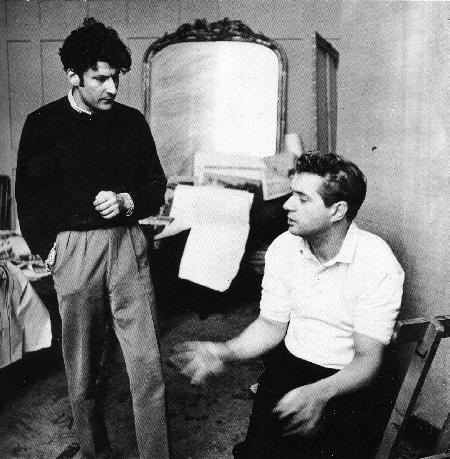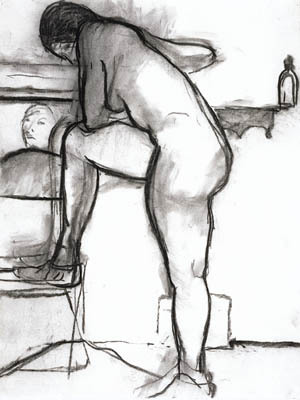attempts at mining the influences
Read MoreNow let us look at the pictures...

analysis
attempts at mining the influences
Read More
lucian_freud_portrait
In response to my mini post concerning the auction house, reader Nick Johnston writes,
"Following the recent sales here in London of Picasso’s painting La Lecteur at c. £25m and now Bacon’s small triptych of Lucien Freud at c. £23m – both to vanish into private, anonymous collections I presume – it’s a salutary reminder that art can always be reduced by the global art trade to secure and lucrative personal investments. No doubt, in 10-20 years’ time, the same paintings will reappear in the major auction houses, and fetch even greater sums for their new owners. Can these works now ever hope to escape the celebrity status of becoming auction house blockbusters and be seen again as paintings, as ART – made not for money but for some kind of love – when the price tags threaten to eclipse them?"
This is partly a question of perspective. It could be argued their celebrity has considerably diminished their potential for being experienced as individual works of art - where they are approached in purely commercial terms, instead of as objects made by an individual, as works with their own historical context.

La Lecture c. 1932
Cheyenne Westphal says Bacon's was "an artwork that radiates 'wall-power'".
Whether a work has 'wall-power' or any cultural resonance is a curiosity that is best explored, not an opinion to be blindly accepted. What we do with our curiosity is key. Without the effort to seek out and experience the work first hand, the artists, and not just their works, remain far removed from any kind of artistic or cultural experience that can be called worthwhile. We are too easily saturated with the digital image, instead of transformed or provoked by the physical matter of a created work encountered in real space and time. In the face of cult celebrity, alienation and vulnerable art market, this is the one physical response we should be encouraging people to have.
Places for this Saturday's workshop at Nyora Studio gallery filled very quickly and I was asked to conduct a second session the following week. Both workshops have sold out too which is great as I get to meet new artists...
Read More
Francis Bacon with Lucian Freud
When personal and financial sacrifices are being made in order to pursue a path with few certainties and even less security, it is worthwhile questioning your motives and objectives behind making work in the first place. I have no interest in painting as recreational activity..
Read MoreA question that has been on my mind of late.. What drives some artists to output work with almost rapid abandon, and others who feel driven to continually re-state, re-work or edit their work?
This is something that I often contend with in the studio, wondering how to strike some balance between bursts of activity and the need to reflect, critically adjust and reshape the output.
So I turned to the work of Richard Diebenkorn (1922-1993).
Had I paid more attention during art history lectures, perhaps I would not have overlooked the significance and strength of this American artist's work.
His drawings strike a strong chord with me as I struggle to balance creative impulse with the rigour of critical revision. As those who have drawn from life will know, forceful and convincing studies of the human form are rarely as simple as the medium (charcoal in this instance) might suggest - as in the following work:

Seated Nude 1966
You can see and almost feel the vigour of Diebenkorn’s thoughts and hand as they interrogate and study human form. The marks which seem to randomly cut across the surface are sensuous without being sentimental – their primary focus is on the overall sweep, weight, presence and gesture of the human subject – a way of responding to both the subtle and bold rhythms inherent in the body.
What does it remind me of ? That each model, each person has their own unique way of projecting this energy so that no two encounters with a live model ever have to be the same. And the work itself can be a testament to that.

Reclining figure1 1962
I love this drawing for all its energy and bold declarations of the reclining form. There is no overworked emphasis on the light, texture or surface of or around the figure. In fact in parts of the drawing it is form itself that appears to be shifting and disintegrating; Diebenkorn's marks have responded to the restlessness and transient nature of the naked human subject (even when drawing or painted from memory, the works project a force and energy one learns to respond to and translate only through observational/life drawing).
There are parts of the work that are erased, omitted or obscured and which inherently lend the works their own sense of mystery and suggestion. But essentially the marks are expressed as marks, the nature of his response and interpretation as the artist are laid out for us with an intensity and rawness that is present in most great drawing.

Untitled (n.d.)
It drives home the lesson that to have the doggedness and courage to reexamine and revise your work is like mining for its true character, believing that out of the process will emerge the constants which define that character.
So the compulsion to revise, adjust and re-examine your work is not all madness or vanity. This method of change itself has the potential to invest the work with meaning.
And that inspires me.